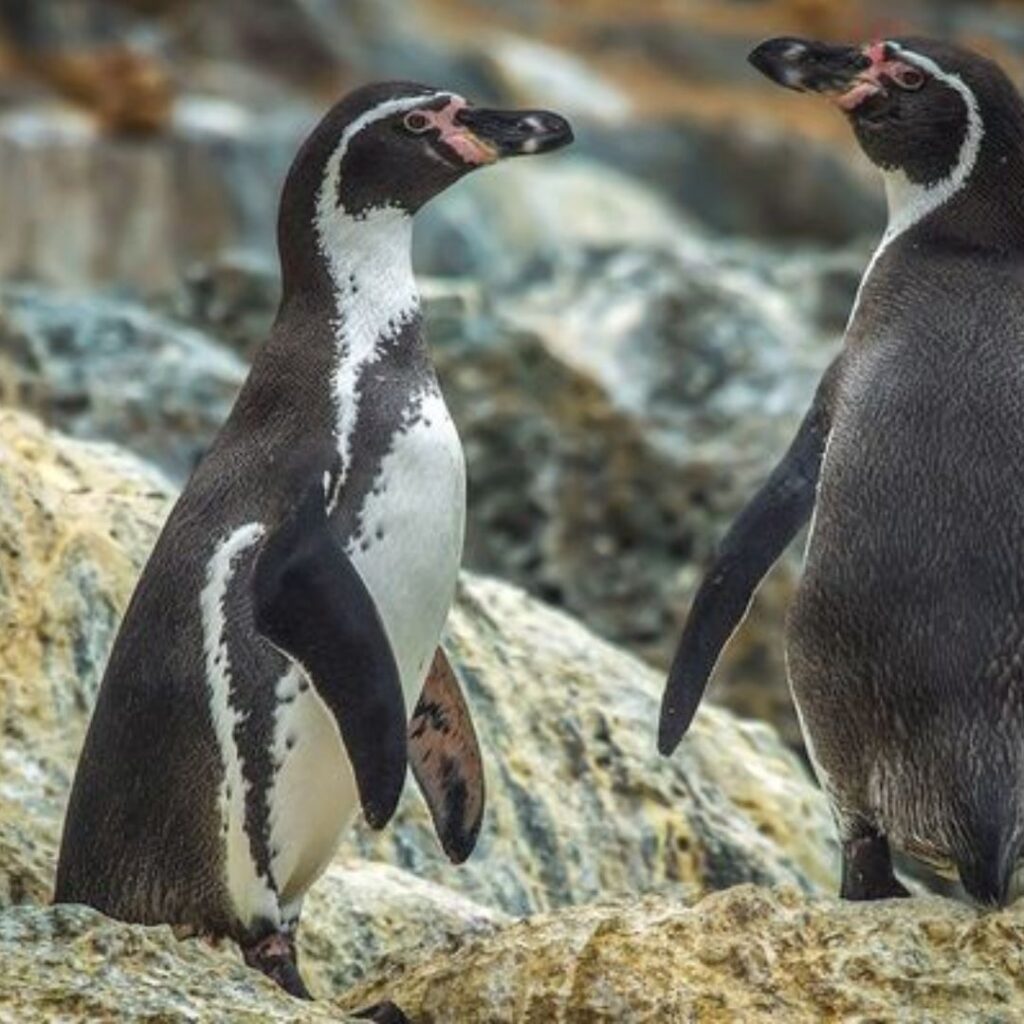
Penguins capture our hearts with their waddling walks and tuxedo-like appearance. Two species that often spark curiosity are the Humboldt penguin and the Magellanic penguin. While these birds share some similarities, they also have unique traits that set them apart. Let’s dive into the world of these fascinating seabirds and explore the differences between Humboldt penguins and Magellanic penguins.
Also Read: 10 Fun Facts About Magellanic Penguins
Habitat and Distribution
Humboldt penguins call the western coasts of South America home. You’ll find them along the shores of Peru and Chile, where they thrive in the cold waters of the Humboldt Current. This current brings nutrient-rich waters to the coast, providing an abundance of food for these penguins.
Magellanic penguins, on the other hand, have a broader range. They inhabit the coasts of Chile and Argentina, extending their territory to the Falkland Islands. These hardy birds adapt well to both the Atlantic and Pacific coasts of South America.

Physical Appearance
At first glance, Humboldt and Magellanic penguins might look similar, but keen observers will spot some differences. Both species sport the classic black and white “tuxedo” look, but they have unique markings that set them apart.
Humboldt penguins feature a black band that runs from their chin to their belly, forming a horseshoe shape. They also have pink patches of bare skin around their eyes and at the base of their beak, which help them regulate body temperature.
Magellanic penguins have two distinct black bands across their white chest. The upper band forms a loop around their throat, while the lower band curves down to their flippers. This pattern gives them a more “formal” appearance compared to their Humboldt cousins.

Size and Weight
When it comes to size, these two penguin species are quite similar. Humboldt penguins stand about 26-28 inches tall and weigh between 8-13 pounds. Magellanic penguins are slightly larger, reaching heights of 24-30 inches and weighing 6-14 pounds. The difference in size is often subtle and can vary among individuals.
Swimming and Diving Abilities
Both Humboldt and Magellanic penguins are excellent swimmers, but they have different diving preferences. Humboldt penguins typically dive to depths of 30-60 feet, though they can reach depths of up to 150 feet when necessary. They usually stay underwater for 1-2 minutes during their foraging trips.
Magellanic penguins are more ambitious divers. They can plunge to depths of 300 feet or more and stay underwater for up to 15 minutes. This impressive diving ability allows them to access a wider range of prey.

Diet and Foraging
The diet of these two penguin species reflects their ocean environments. Humboldt penguins primarily feed on anchovies, sardines, and squid found in the nutrient-rich Humboldt Current. They often hunt in groups, working together to corral schools of fish.
Magellanic penguins have a more varied diet. They feast on small fish like anchovies and sardines, but also enjoy squid and crustaceans. These adaptable foragers can travel up to 25 miles offshore in search of food.

Breeding and Nesting Habits
Both Humboldt and Magellanic penguins form monogamous pairs and often return to the same nesting sites year after year. However, their nesting preferences differ slightly.
Humboldt penguins prefer to nest in caves, crevices, or burrows along rocky coastlines. They lay two eggs and both parents share incubation duties, which last about 40-42 days.
Magellanic penguins typically dig burrows in the ground or nest under bushes. They also lay two eggs, and their incubation period lasts around 39-42 days. These penguins form large colonies during the breeding season, creating bustling penguin “cities” along the coast.

Conservation Status
Both Humboldt and Magellanic penguins face challenges in the wild, but their conservation statuses differ. Humboldt penguins are classified as vulnerable due to threats like overfishing, habitat destruction, and climate change. Their population has declined significantly over the past few decades.
Magellanic penguins, while not currently endangered, are listed as near threatened. They face similar challenges to Humboldt penguins, including oil spills, fishing net entanglements, and changes in food availability due to climate change.

Unique Behaviors
Humboldt penguins have developed an interesting adaptation to their warm coastal habitat. They have bare patches of skin that help them cool down by increasing blood flow to these areas. This feature sets them apart from many other penguin species.
Magellanic penguins are known for their impressive migrations. Some individuals travel over 4,000 miles in search of food, showcasing their remarkable endurance and adaptability.
Also Read: Where Do Magellanic Penguins Live?

Conclusion – Humboldt Penguin vs Magellanic Penguin
While Humboldt and Magellanic penguins share many similarities as South American seabirds, they each have unique traits that make them special. From their distinct markings and diving abilities to their nesting preferences and conservation needs, these charming penguins continue to captivate both scientists and nature enthusiasts alike. By understanding and appreciating the differences between these two species, we can better appreciate the diversity of penguin life and the importance of protecting their ocean habitats.
Pingback: Is the Magellanic Penguin Extinct?
Pingback: 17 Unique Water Birds of Oklahoma